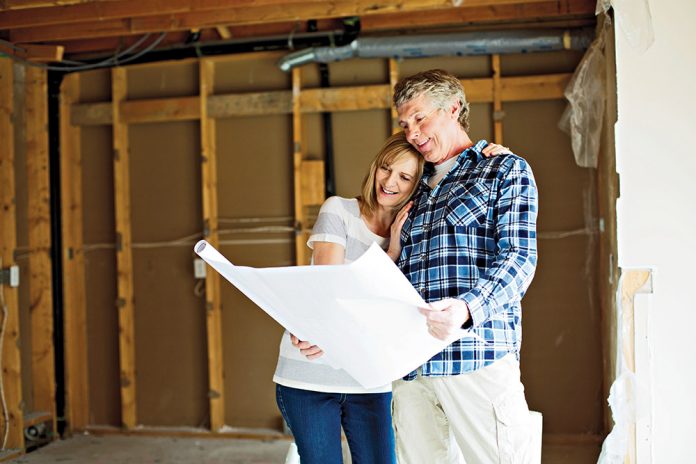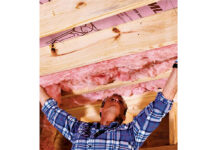By Natasha Rombough, Director of Marketing and Communications, CHBA
Housing is more complex than the average Canadian realizes. But its intricacies are well known to anyone in the residential construction industry. And for those who focus on high performance housing, especially Net Zero homes, the challenges and barriers can be formidable if you’re trying to tackle them alone.
CHBA’s Towards Net Zero Renovations initiative is assembling experts to tackle those roadblocks for home renovations together. It’s bringing key players together to educate, collaborate and build Canada’s capacity to achieve its emissions targets. In addition to the valuable perspective and input from renovators and energy advisors, the five-year initiative also has municipalities, building inspectors and manufacturers at the table to raise awareness of what it will take to retrofit Canada’s housing stock.
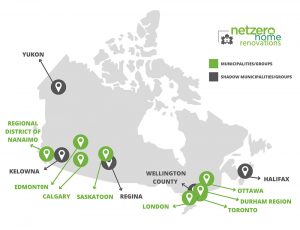
Why retrofits
Canada has committed to achieving net-zero emissions by 2050. While the focus in the housing sector is often on new construction homes, even if all new homes built from now until 2050 were built to zero emissions, we would not hit our target. To reach Canada’s goals, the existing housing stock must be renovated for improved energy efficiency.
There are more than 16 million existing homes in Canada, almost all of which can improve their energy performance. Many are also ripe for aesthetic and functional renovation and repair, which is often the best time to also renovate for energy efficiency as part of a larger renovation. This is especially true if the siding is being replaced, since improvements to the building envelope, especially the airtightness, are the most impactful to improve the home’s energy efficiency.
This is a big opportunity for renovators. To bring as many homes as possible to net zero, it’s going to require that an army of people understand what it takes. That’s where the Towards Net Zero Renovations initiative comes in.
About the initiative
CHBA and its members have a long history in leading energy efficiency in residential construction. The latest evolution has been the CHBA Net Zero Home Labelling Program, which was piloted in 2015 and currently has more than 1,400 homes labelled across Canada. Building on that success, after a two-year pilot CHBA officially launched its Net Zero Home Labelling Program for Renovations in October 2021.
The Net Zero Home Labelling Program provides the industry with a clearly defined and rigorous two-tiered technical requirement that recognizes Net Zero and Net Zero Ready Homes (for new and existing homes), as well as the builders and renovators who provide them. A national network of CHBA Net Zero qualified service organizations, energy advisors and trainers work directly with the renovators to design, model, test and inspect each renovation.
In early 2022, CHBA, with financial support from Natural Resources Canada, officially announced this new initiative titled “Towards Cost-Effective Net Zero Energy Ready Residential Renovations.” In collaboration with participating Canadian municipalities, local home builders’ associations, renovators and industry partners, the initiative’s objective is to target barriers to achieving net zero ready performance in existing homes, and to determine the most cost-effective solutions to renovating for higher levels of energy efficiency, including targeting Net Zero and Net Zero Ready.
Connecting with stakeholders
Lynne J Strickland, CHBA’s Director, Initiatives, Net Zero Housing, is heading up the project. She says that the model of this initiative is unique in that municipalities that are incentivizing deep energy retrofits and/or net zero projects (typically via funding obtained through the Federation of Canadian Municipalities) are key project stakeholders in outreach for homeowner participation. CHBA is working with the municipalities to help accelerate their goals through the work of CHBA’s current net zero builders and renovators, prospective new members, and their network of industry professionals associated with their projects.
There are eight participating municipalities: The Regional District of Nanaimo, Edmonton, Calgary, Saskatoon, London, Toronto, Durham Region and Ottawa. These participants are exchanging staff time in return for training and net zero consulting support for the constituents in their area. They’re also responsible for determining which homes within their incentive program might be best suited to a net zero renovation, and then bringing those homeowners who are interested onboard in the hopes that the scope of their renovations can be elevated to get closer to net zero.
Five additional municipalities/regions are shadowing the project: The Yukon, Kelowna, Regina, Wellington County and Halifax are either in the process of developing their own incentive programs, are assessing where net zero fits into their programs or are in rural or remote areas that are considering implementing programs in the future. Along with the other eight municipalities, these five shadow participants attend the municipal working group meetings and benefit from the same information exchanges and networking. As with the other municipalities, part of the initiative’s funding will also allow training to be brought to the shadow municipalities/regions to build industry capacity.
The participating municipalities get together to receive updates from CHBA on the project, relay their barriers and capacity issues, to request support in communicating with homeowners, discuss financing models and to share what homes or archetypes might benefit from participating. Some are using properties they own, and others are canvassing homeowners, either on their own or through third party programs they’re working with.
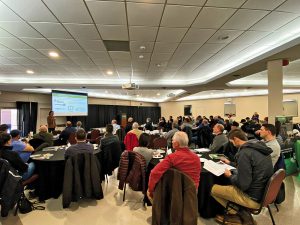
Creating efficiencies
To accurately identify barriers and pain points, it was determined that an industry scan was needed. CHBA brought together its lead consultant on the project, Building Knowledge Canada, and a Net Zero Reno Advisory Group, consisting of experienced members from across Canada, to identify the roles and tasks that happen throughout a net zero renovation, and the approximate time commitment needed for each. Through that exercise, they found that to move a renovation project from initial discussions, through the design phase and into a contract the homeowners can sign, the time spent by energy advisors (EAs) was more than double that of renovators. “The first thing we needed to do was find and leverage tools to reduce the time needed by needed by EAs to perform the necessary calculations so that hiring an EA to do that work would be less cost-prohibitive to homeowners, and therefore more accessible for them to engage an EA,” says Strickland.
To do that, CHBA looked to leverage tools for industry that Natural Resources Canada (NRCan) was already developing through their Local Energy Efficiency Partnerships (LEEP) program. NRCan has been working with a not-for-profit called Volta Research Inc. to optimize several existing NRCan tools and make them available on a secure online server, functioning much faster to compute various aspects of home modelling. This would essentially allow an EA to sit down with a homeowner and make adjustments to the modelling in real-time rather than waiting hours or even days for calculations to run, allowing them to find the best options for the renovation – a game changer according to EAs who have tested the software. Due to the significant benefits this tool offers, the initiative is partially funding the development and roll-out, so that all renovations that are part of the initiative will be able to use it.

Training
The other major barrier identified through another industry scan was lack of training on how the integrated design process (IDP) should function for home renovations, especially when evaluating the cost-effectiveness of energy, emissions, and resiliency opportunities.. CHBA worked with NRCan and the Canadian Association of Consulting Energy Advisors (CACEA) in the summer of 2022 to explore existing resources for the IDP and customized them for the project’s 10 phases of a home renovation.
To deliver the training, which is paid for by the initiative, CHBA works with local home builders’ associations and municipalities to host in-person Net Zero Reno Bootcamps. Together with the CHBA Qualified Net Zero Trainers and Service Organizations, they encourage everyone in their networks to attend the Bootcamp, to cast a wide net and get as much regional participation as possible. To enroll, participants must first successfully complete a virtual Advanced Building Science prerequisite. The Bootcamp is a compressed intensive 2-day lineup that includes the Net Zero Builder Trainer (which focuses on how to achieve Net Zero), an introduction to the Integrated Design Process, and then the Net Zero Renovator Training. “With this Bootcamp we expanded it to every single stakeholder group in the chain, including building officials, the HVAC industry, solar consultants, students, energy advisors, renovators and builders – so that everyone a renovator and EA would be working with all receive the same information,” says Strickland.
Another desired outcome is building a local Net Zero Network and highlighting the benefit of leveraging the local homebuilders’ association as a go-to resource for municipalities and other stakeholders when they need information or qualified professionals to help guide or lead these types of projects.
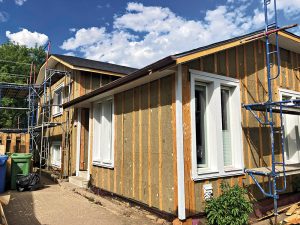
Renovations
Next up for the initiative is the actual renovations. The goal is to have 100 to 150 Net Zero or Net Zero Ready Renovations by the end of 2024, which Strickland says is going to be a very challenging number to hit. Ideally, 10 to 15 renovations will be completed in each municipality so that there is a healthy geographic and climate zone variety. Even better would be homes with various architypes, but it’s not required. Strickland is currently looking for renovators and energy advisors with clients looking to undergo a Net Zero or Net Zero Ready Renovation within one of the participating municipalities/regions.
One of the advantages to being part of the initiative is that the fees for your Qualified Net Zero Energy Advisor services and the cost of getting the home labelled will be funded by the initiative. So, if you’re a renovator or an energy advisor with a renovation coming up where the homeowner has expressed interest in going to Net Zero, Strickland encourages you to enroll. “You don’t have to be a Net Zero Renovator already to enroll, and there’s no obligation with enrollment to complete a Net Zero Renovation. Enrolling simply logs your project with CHBA, and qualifies it for the energy advisor to determine if the home is capable of getting to the level of energy improvement required to be part of the initiative.” As part of the initiative, there is also direct engagement with the municipality to explore all available incentives and rebates. Some participating municipalities are offering additional incentives for achieving Net Zero.
Next steps
After the renovation is complete, a full year of energy data for each home will be required by December 2025 to allow for analysis and reporting. Homes that achieve Net Zero or Net Zero Ready will be qualified through CHBA’s Net Zero Home Labelling Program to receive recognition, meaning more renovators will become qualified through the program as well. To complement this growing industry capacity, there must be well researched recommendations for effective rebates and incentives that result in homeowners voluntarily renovating for energy efficiency, and that’s something that will also be tackled through the initiative. And finally, the information learned over this massive multi-year process will be disseminated to industry, governments and the public through a variety of avenues at the conclusion of the initiative.
Strickland is looking forward to seeing the strides that will be made over the next couple of years. “This initiative has already highlighted what is working in one area, what’s not in another, and what we need more of across the country. That knowledge is helping us to start to address gaps and make improvements that will benefit our members, the entire industry, municipalities, and Canadians.”







